Since the 1950s, when the concept of marketing was first introduced, the marketing scene has changed significantly. In earlier times, when traditional marketing was prevalent, there was no internet. So magazine ads, catchy radio tunes, and billboards on major highways were the primary means for advertisers to reach the mass market, often annoying consumers. This period was the golden age of advertising; businesses ran bold, in-your-face ad campaigns that lined the streets, targeting as many people as possible. The technique was crude: spray and pray; just blast everyone with your message and hope it sticks.
However, with the advent of technology, marketing methodologies kept improving. As the '90s wound to a close, the internet offered new possibilities for how businesses interacted with their consumers. As a result, direct selling and network marketing emerged, representing a more personal approach to customers. Traditional advertising is still common, but in network marketing, personal relationships are essential. It relies on the power of personal recommendation or word-of-mouth.
This blog talks about the evolution of marketing, starting from its traditional methods to the modern world of network marketing. Point-by-point analysis of the core differences between the two, the reasons why they are very helpful separately, and also how to efficiently use them in the current dynamic market. Whether you are an experienced marketer who wants to keep his or her strategies up to date or a beginner looking for the basics, this guide provides very valuable information on both, and it will help you understand the wide world of marketing that is still developing massively.
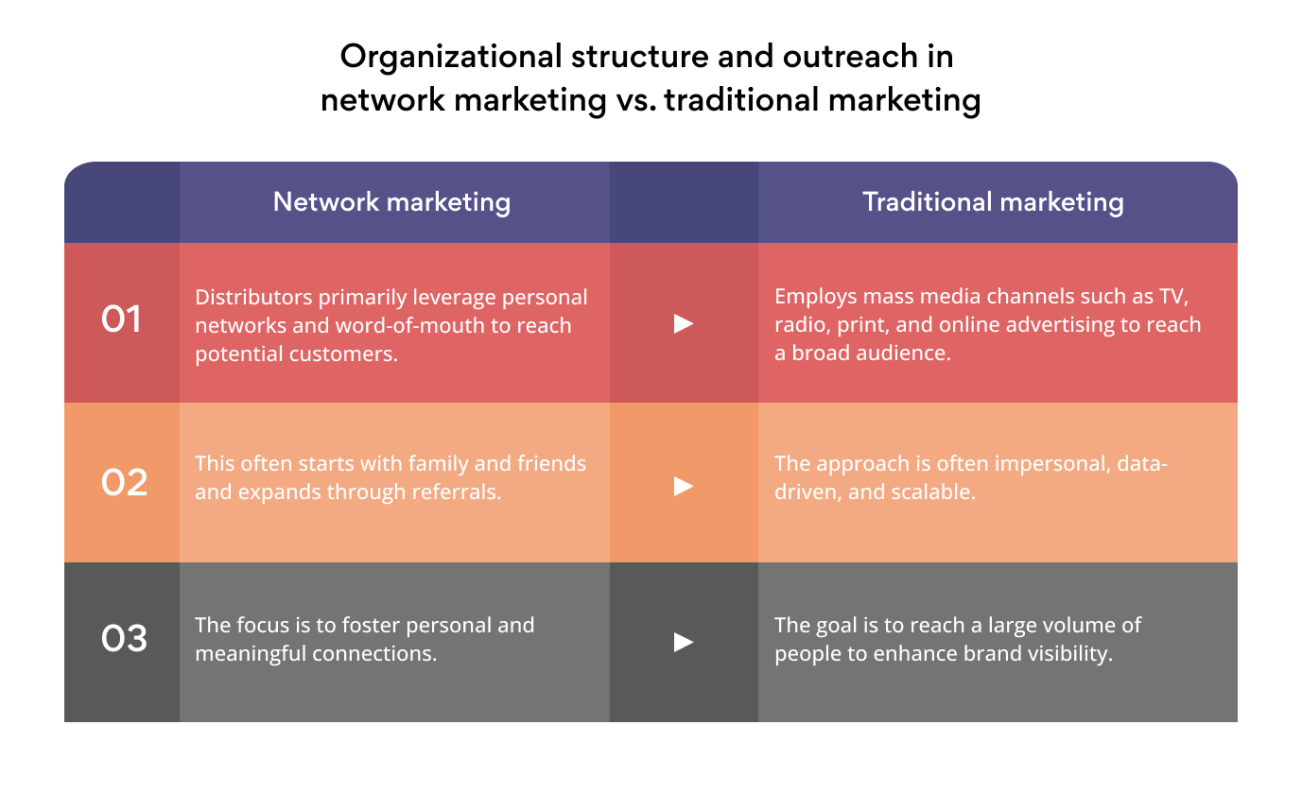
Organizational structure and outreach
Traditional brand marketing is mostly about casting a wide net. Think about the TV commercials, radio jingles, eye-catching print ads, and those omnipresent digital banners. The goal? Get as much reach as you can. These campaigns cost an arm and a leg for multi-level marketing companies and are focused primarily on brand building and revenue through exposure. It is like shouting from the rooftops—to anyone and everyone who cares to listen to it. This is about volume—getting your message out to a broad audience and cementing a strong market identity.
With network marketing, however, this approach is a bit more personal and grassroots. This model is based on direct selling. Imagine people—we will refer to them as distributors—who sell products directly to friends, family, and acquaintances and recruit distributors to their selling network—but with a twist. This provides an incentive for those already within the system to recruit, as you end up making money not just for your sales but when your recruits sell, in a tiered network marketing structure. It's mostly about working with people you already know. Network marketing uses trust and personal connections to make a sale instead of a one-size-fits-all message blasted to the masses. A friend recommending a product to you sounds a lot better, more relatable, and trustworthy, right?
In short, traditional marketing is more like shouting a message through a megaphone in the town square, and network marketing is having a heartfelt conversation with a friend, building a network of trust and personal relationships. Yes, indeed, they both have various strengths and serve different purposes in sales and marketing.
Earning framework and potential rewards
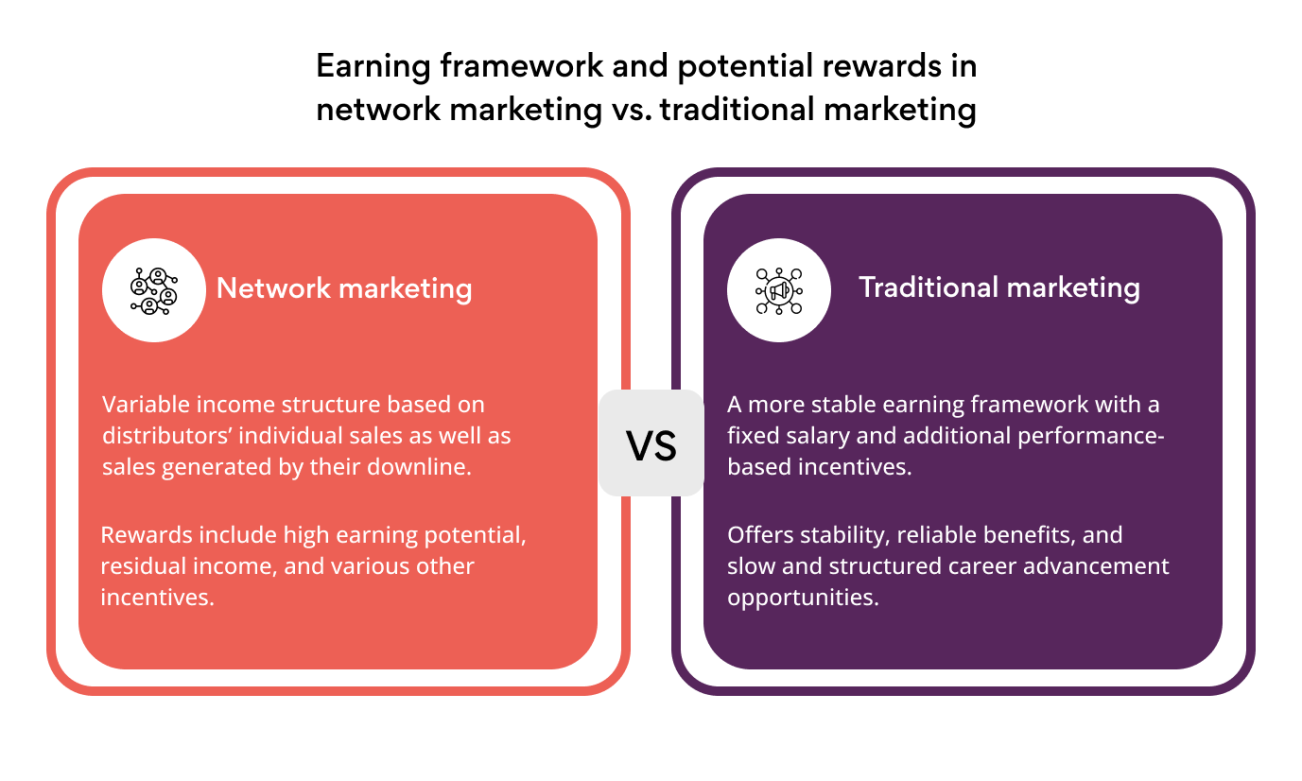
In the traditional marketing world, marketers typically receive a salary with minor commissions on sales value. If you are on a sales team, your earnings could include group performance bonuses. Career advancement follows a linear progression—climbing the corporate ladder. You start from the bottom and work your way up. Performance reviews, tenure and sometimes office politics are usually linked with raises and promotions. It's a nice, even, slow, and reliable way to grind out a living, but the payment ceiling is typically limited by the organization under which you work and the norms of the industry.
Network marketing (MLM) is where things start to get more dynamic. MLM distributors make money by marking up their own direct sales, but that's not nearly all! The real magic happens when they begin networking. With each new recruit in their downline, the potential earnings increase because they now have multiple streams of income. Such an MLM structure can mean that you generate revenue while you sleep, as you will continue to profit from the sales of your downline. In theory, there's no limit since the deeper and more active your network, the more you can earn. Network marketing’s success is primarily determined by your input, your sales skills, the number of people you can recruit, and your ability to motivate those you recruit. The idea favors those with a hardworking mindset and can deliver huge payouts if you know how to create a strong team.
In comparison, traditional marketing has a fixed-income commitment, but network marketing is an opportunity for earning money that no other way can provide you as long as you work and grow your network. A stable salary versus an uncertain master-class bonus grind.
Channel of product distribution

Most commonly, in traditional marketing, products find their way to consumers through established retail channels. This can be a broad range from big-box stores and boutique shops to name-brand online marketplaces like Amazon or the company's own ecommerce site. Their engagement with the business has more to do with the business itself than with individual salespeople. You simply walk into a store, grab what you need, and sometimes talk to a cashier—no more than that. This incorporates offering a convenient and streamlined shopping approach using the power of the brand itself and ease of access across the country.
Network marketing is just the opposite. This involves selling to consumers directly through distributors. This bypasses the traditional retail setting for a more personalized purchase. One of these is distribution via independent sales reps, sometimes selling at home parties, social gatherings, or in a one-on-one setting due to their network of relationships. It actually enhances this personal interaction and strengthens trust in these networks. It's not merely selling a product; it's telling someone you know what you genuinely use and recommend. The distributor turns into a consultant, and this human element adds a great deal of influence to the purchasing patterns.
To conclude, conventional marketing is retail channel-based and uses business-to-consumer interactions. On the flip side, network marketing is founded around direct selling and personal connections versus traditional retail sales, orienting around trust and engagement through personal networks.
Customer engagement
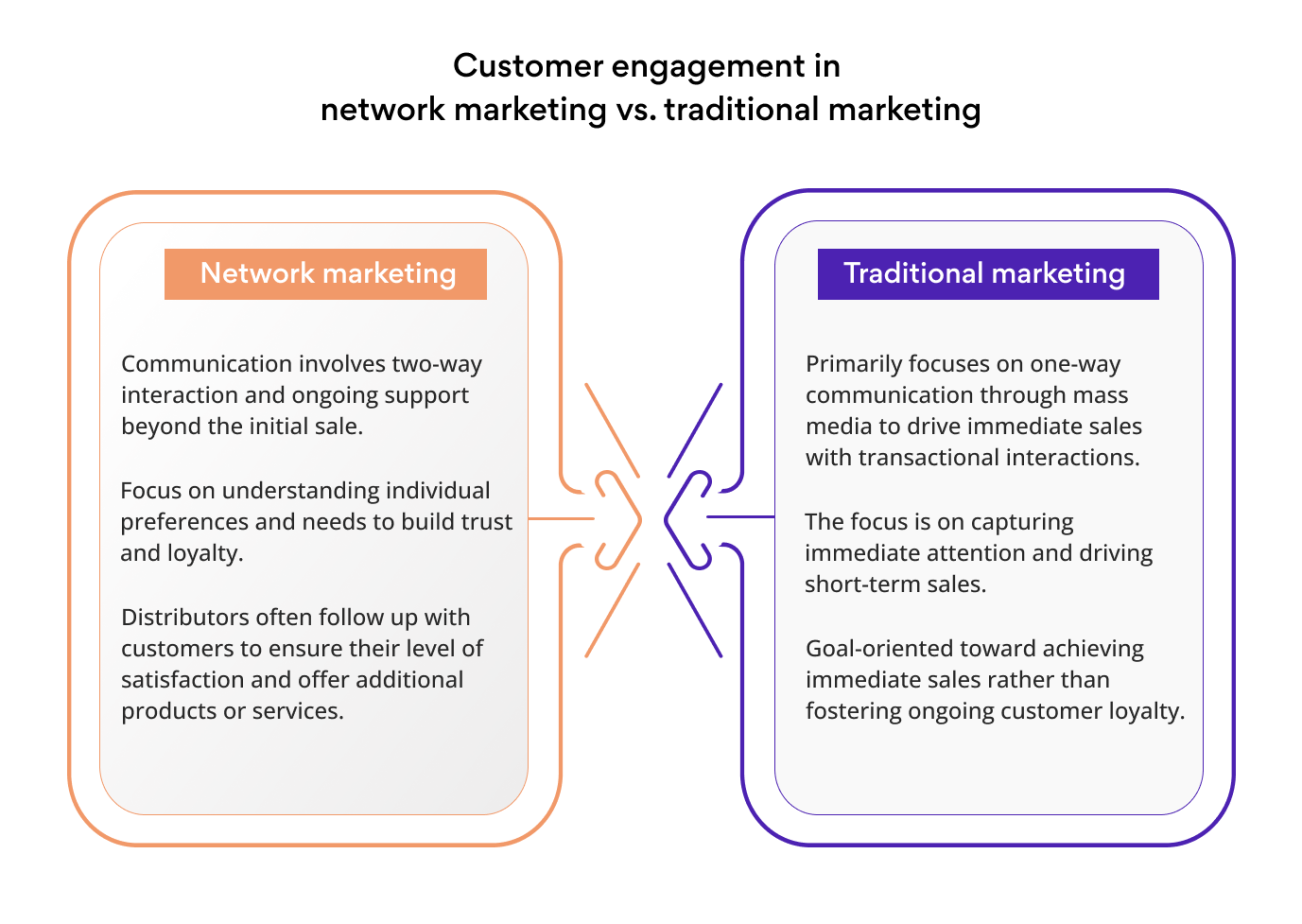
In traditional marketing, customer engagement is a one-way street. The brand broadcasts its messages to a largely passive audience. The advertisement itself will be quite simple—you've typically seen them on TV, with catchy radio spots, eye-catching billboards, and digital banners going up as you browse. This interaction is very low and usually just in response to these ads or offers. For instance, an ad can catch your eye for a new gadget; from there, you might check the website or head into the store to make a purchase. This engagement is very much transactional. The main goal? Drive immediate sales. It does the job of getting the attention of the consumer and convincing them to make a purchase right away, not necessarily focusing on them coming back in the long run.
Reverse that thought, and there we have network marketing, where engagement is of a more interactive and intimate variety. Distributors are not just selling products; they are building relationships. The service provides tailored advice and recommendations relating to each customer's personal requirements and tastes. It is not simply about buying one-time and creating a big payoff. Distributors ensure follow-ups for a certain period of time to verify customers are happy with the product and further suggest other products that could work similarly for them. Instead of just making a quick sale, the focus is rather on building relationships that last long.
Considering consumers as individuals helps foster loyalty—the more consumers are heard, the more they are understood. By making customers feel appreciated and listened to, a one-time buyer can be turned into a recurring one.
Traditional marketing tries to catch as many fish as it can, focusing solely on the quick buck, whereas network marketing is a finely tuned spearfisherman. Is there a benefit to network marketing? Absolutely!
Initial investment and associated risks
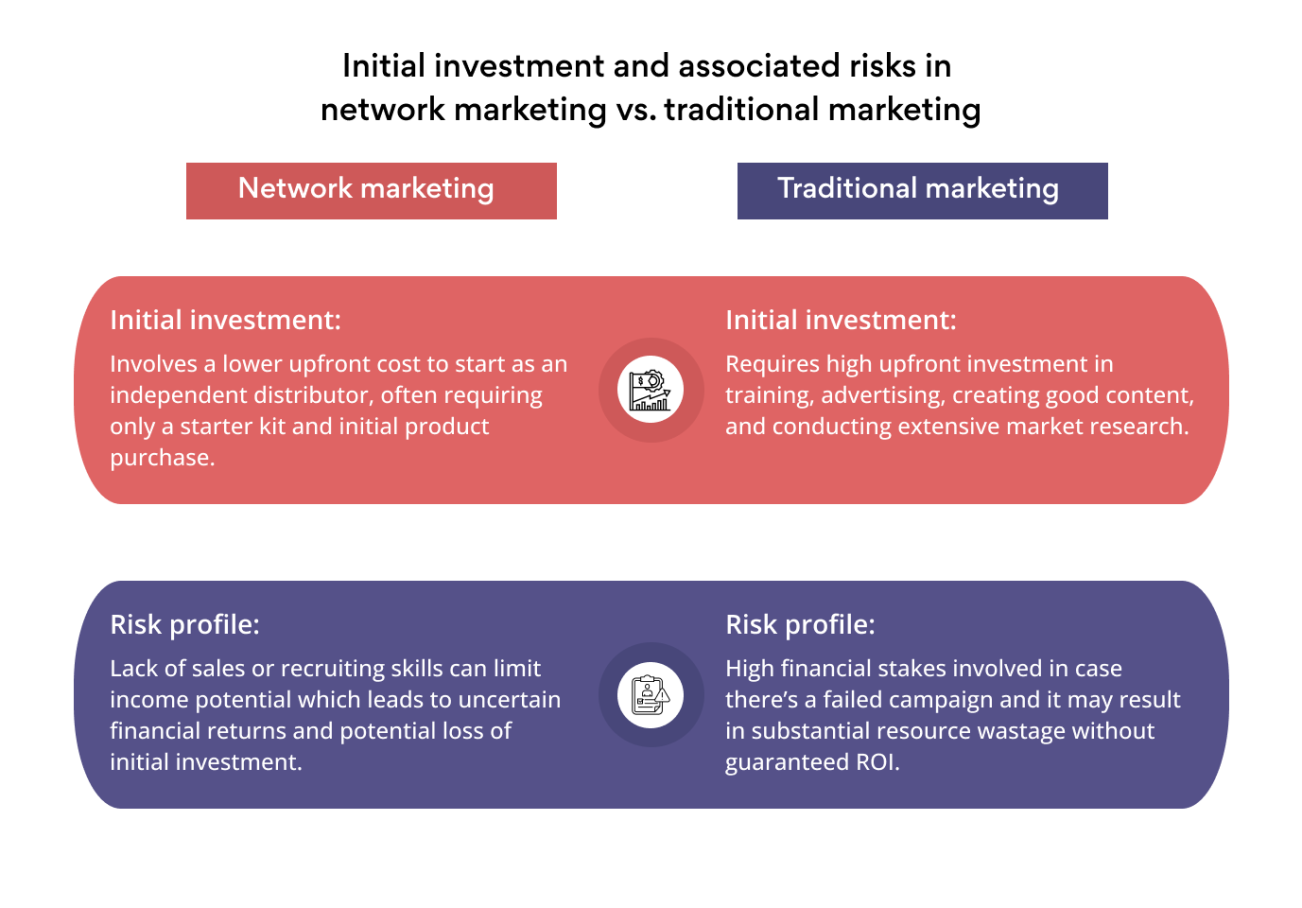
Traditional advertising traditionally requires a sizable monetary investment upfront. We are speaking about big investments in education and training, sometimes necessitating certain credentials to get your foot in the door. The employment arena is highly competitive and your brand must be continually marketed to maintain brand visibility and be top of mind. It could be for buying an ad space, creating good content or researching a lot about the market—it can get expensive very fast. The risk here is tied to these high financial stakes. A failed campaign could mean a considerable waste of resources with no certain ROI.
For network marketing, on the other hand, it typically involves a relatively lower initial investment. For many people, this accessibility is one of the big benefits of starting their own company with little upfront cost. Learn everything you need to know, including how to start. You may just need a starter kit and some initial products to get started, but the success rate is still poorly understood. You may be risking less financially without spending hundreds of thousands on large-scale marketing campaigns, but you have everything to lose personally. If you are successful, you will be well compensated. If not, it is more typical that your income is heavily based on your ability to sell and socialize. If you are not good at sales or recruiting, then the money you earn will never be very significant and you may not even get back what you initially put in if things go south.
To sum up, traditional marketing is for you if you can afford to allocate a lot of money and is high-risk, whereas network marketing requires little money to start with but is still high-risk (personal and network risk). You can either gamble your money in an orderly (but potentially boring) setting or you can gamble your sweet convincing skills, charisma, and network-building know-how.
Technology utilization
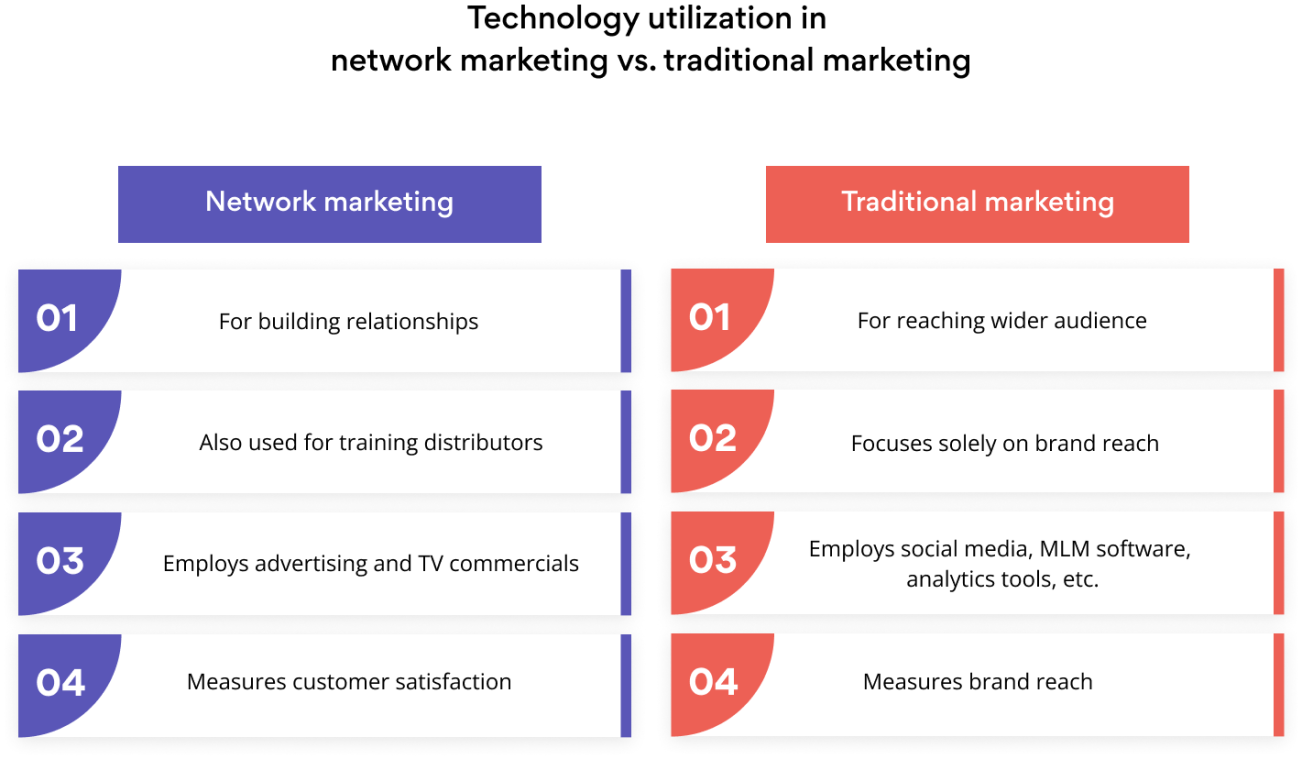
Traditional marketing is basically about reach and measurement in old-school marketing fashion. It uses advanced data analytics, automation, and digital platforms companies require to effectively target very large audiences at their fingertips. Examples of some tools are customer relationship management (CRM) systems, online advertising platforms, and advanced analytics software. The technology allows companies to run sophisticated multimodal, multi-channel campaigns across anything from television commercials and digital ads to newspapers. For example, CRM systems look after customer interactions, and online advertising platforms like Google Ads and Facebook Ads can help you target and retarget your customers. This actually means that the performance of these campaigns is tracked and feedback is provided as to what works and what doesn't, driving continuous improvement and enabling them to maximize their marketing ROI.
By contrast, network marketing is a technological means of keeping in touch and developing networks. An important tool here is MLM software, which helps in maintaining intricate distributor networks and scaling payment plans easily. These tools help in tracking and recording sales and recruitment activities, which is important for the calculation of commissions and bonuses. A practical example of this is the dashboard a distributor uses to follow their own sales and the performance of those they sponsor, as well as manage customer groups. Equally important are distributor training platforms and communication tools that allow distributors to directly access the training materials, webinars, or immediate contact with their upline or downline from any location. All of this is possible because it supports the direct selling approach via recruitment, sales tracking, and network marketing tools enabling distributors to be able to function efficiently even amidst geographical dispersion.
Technology will empower distributor training and marketing initiatives for network marketing too. Before diving into an online training platform, you are rewarded with a vast treasure trove; from video tutorials to webinars and e-books as well as interactive courses. These tools help prepare distributors with the specific skills and knowledge required for growth. In addition to this, social media and other digital marketing channels empower distributors to advertise new products, recruit talent and improve their social selling skills. With this, distributors are able to carry out their marketing plan in a consistent manner using tools like email marketing software, social media scheduling apps, and/or content management systems.
Traditional marketing centers on capitalizing on reach and campaign performance for a wide audience with the use of sophisticated technologies for actionable insight and campaign tailoring. Whereas the network marketing approach focuses on increasing the depth of relationships and operational efficiency in this decentralized, distributor-driven model. These strategies draw on the technology most appropriate to each—traditional marketing for mass reach and granularity as well as the basic, social-contact side of network marketing for personal contact interaction, management of networks, and training.
Discover how we build resilient businesses with advanced MLM functionalities
To conclude
When we compare traditional marketing with network marketing, both are different in their own ways, as each offers its own strategies tailored to the needs of the business and environment.
Traditional marketing uses broad media like newspapers and television to target a huge number of audiences, which increases scale and reach to generate sales through some of the most popular platforms. This approach utilizes heavy media campaigning and is built on organizational hierarchies, which offer secure wages and career progression in a corporate environment.
On the other hand, network marketing is very personal and is based on sales. It has a very strong emphasis on relationships and direct consumer sales—no traditional retail model here. This approach is often more flexible in terms of the initial investment and potential revenues, but is heavily reliant on the ability to expand and maintain a successful network.
But ultimately it comes down to what best suits your vision, resources, and ideal method of working. There are pros and cons to both methods, so the decision should be made carefully based on an individual's preferences.









Leave your comment
Fill up and remark your valuable comment.